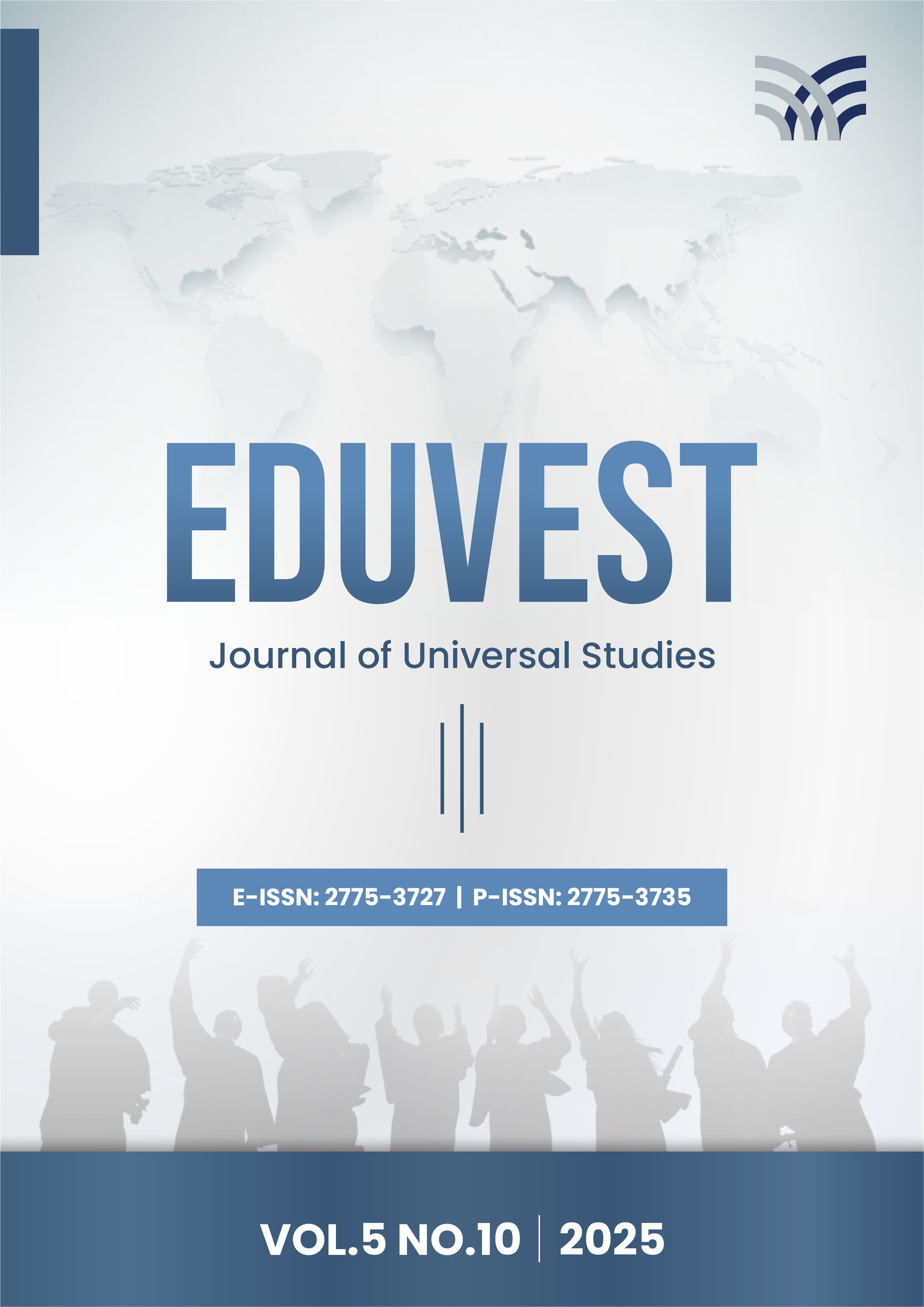Critical Discourse Analysis of Textual Dimensions in the Editorial of Derap Guru Magazine
##semicolon##
https://doi.org/10.59188/eduvest.v5i10.51261##semicolon##
critical discourse analysis##common.commaListSeparator## editorial##common.commaListSeparator## Norman Fairlclough's theoryAbstrakt
Mass media plays a crucial role in shaping public perception of the teaching profession through discourse construction and representation strategies. This study analyzes the editorial discourse in Derap Guru magazine using the critical discourse analysis approach based on Norman Fairclough's theory. Data were obtained from the print edition of Derap Guru magazine published in 2024. The problem in this study concerns how the representation of teachers in the editorial column of Derap Guru magazine is examined through a critical discourse analysis study of the textual dimension. The purpose of this research is to describe the representation of teachers in Derap Guru magazine published in 2024. The research method used is a qualitative descriptive approach, presenting data in the form of words, phrases, and sentences rather than numbers resulting from statistical calculations. The findings indicate that the representation of teachers in Derap Guru magazine is biased in favor of teachers. This is evident in the media’s tendency to emphasize certain aspects that contribute to building stigma or a particular perception of teachers as a group. The tendency to highlight specific issues constructs stigmas or perceptions about teachers as a professional body, revealing tensions between state policies, digital literacy demands, compensation adequacy, and professional respect. This research contributes to understanding how specialized educational media employs discourse strategies to advocate for teacher interests while upholding journalistic credibility.
##submission.citations##
Ball, S. J. (2013). The education debate (2nd ed.). Policy Press. https://doi.org/10.1332/policypress/9781447326106.001.0001
Creswell, J. W., & Poth, C. N. (2018). Qualitative inquiry and research design: Choosing among five approaches (4th ed.). SAGE Publications.
Fairclough, N. (2013). Critical discourse analysis: The critical study of language (2nd ed.). Routledge. https://doi.org/10.4324/9781315834368
Fairclough, N. (2015). Language and power (3rd ed.). Routledge.
Gee, J. P. (2015). Social linguistics and literacies: Ideology in discourses (5th ed.). Routledge.
Giroux, H. A. (2011). On critical pedagogy. Bloomsbury Academic.
Halliday, M. A. K. (2014). Halliday's introduction to functional grammar (4th ed., revised by C. M. I. M. Matthiessen). Routledge.
Halliday, M. A. K., & Matthiessen, C. M. I. M. (2014). Halliday's introduction to functional grammar (4th ed.). Routledge.
Harjatanaya, T. Y., & Harto, S. (2021). Representasi guru dalam wacana media daring Indonesia: Analisis wacana kritis perspektif Foucault. Jurnal Komunikasi Indonesia, 10(2), 87-102. https://doi.org/10.7454/jki.v10i2.528
Jaya, I. M. L. M. (2020). Metode penelitian kuantitatif dan kualitatif: Teori, penerapan, dan riset nyata. Quadrant.
Kusuma, R. A., & Wijaya, D. (2020). Analisis wacana kritis kebijakan pendidikan dalam surat kabar nasional. Jurnal Pendidikan dan Kebudayaan, 5(1), 45-61.
Maysarah, M., Siregar, F. R., & Lubis, S. (2024). Analisis wacana kritis teks opini ironi konservasi Taman Safari dalam Majalah Tempo edisi satwa ilegal Taman Safari. ARGOPURO: Jurnal Pendidikan Bahasa dan Sastra Indonesia, 3(1), 12-25.
Mulderrig, J. (2011). The grammar of governance. Critical Discourse Studies, 8(1), 45-68. https://doi.org/10.1080/17405904.2011.533563
Mulyadi, A. M. (2021). Dasar-dasar jurnalistik: Teori dan praktik. Komunika.
Noddings, N. (2013). Caring: A relational approach to ethics and moral education (2nd ed.). University of California Press.
Nuraeni, L., Suryadi, K., &Asyari, D. (2022). Representasi kesejahteraan guru dalam wacana media massa: Analisis wacana kritis model Van Dijk. Jurnal Ilmu Sosial dan Ilmu Politik, 11(3), 234-250.
PGRI. (2024). Derap Guru. Pengurus Besar Persatuan Guru Republik Indonesia.
Santoro, D. A. (2018). Demoralized: Why teachers leave the profession they love and how they can stay. Harvard Education Press.
Selwyn, N. (2011). Education and technology: Key issues and debates. Continuum.
Setyaningsih, R., Wardani, N. E., & Saddhono, K. (2023). Representasi guru dalam media sosial: Analisis wacana kritis multimodal. Jurnal Pendidikan: Teori, Penelitian, dan Pengembangan, 8(2), 156-172.
Van Dijk, T. A. (2015). Critical discourse analysis. In D. Tannen, H. E. Hamilton, & D. Schiffrin (Eds.), The handbook of discourse analysis (2nd ed., pp. 466-485). Wiley Blackwell.
Wodak, R., & Meyer, M. (Eds.). (2023). Methods of critical discourse studies (4th ed.). SAGE Publications.
##submission.downloads##
Publikované
##submission.howToCite##
Číslo
Sekcia
##submission.license##
##submission.copyrightStatement##
##submission.license.cc.by-sa4.footer##










